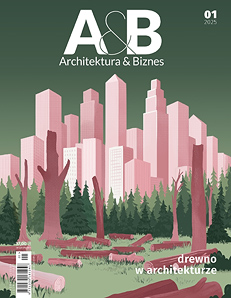Demography is the future, and in the case of Poland, it is a signal of great importance. An aging society is a challenge not only on the economic level, but also on the spatial level. We discuss how our cities should be rebuilt in this context with Agnieszka Labus from the Architecture 60+ Laboratory and the Faculty of Architecture at the Silesian University of Technology - an architect who specializes in the subject of adapting cities to the needs of longevity.
Wiktor Bochenek: Are cities in Poland ready for the increase in the number of seniors? Are cities prepared for the problems we will face?
Agnieszka Labus: It is worth knowing what kind of world we are functioning in - what are the trends, tendencies and what changes are accompanying us. It is said that we are functioning in a world of polycrises. Demographic changes, including an aging population, are one of the global challenges that directly affect how we live and where we function. And with more than 60% of the world's population living in cities, this significantly affects many areas of our lives. In Poland, as in other European countries, there is a tendency to talk abouta "demographic tsunami" that is coming, because there is an increase in the number of people over 60 in society.
I see this perspective quite differently, as a certain asset, even an opportunity, because the fact that we are getting older means that we are living longer. In the 1960s, the average life expectancy in Poland was about 53 years. The Central Statistical Office reports that today it is 73 years for men and 81 for women, but it is worth noting that in health we live about 60.1 years for men and 63.7 for women. According to Eurostat, 19 EU countries live longer than Poland. This is influenced by the level of advancement in the context of education and healthier lifestyles, preventive health care, modern technologies and better developed medicine. I wanted to point out this change in perspective, that is, not the issue of aging, but the fact that society is living longer and we need to be prepared for what this means. This approach is not just about years and years of life extension, but about so-called healthy longevity - so that we are as independent as possible for as long as possible, and this can be greatly helped by the environment and properly shaped cities, spaces, buildings, places where we buy, work, study, rest.
our model of life is changing
© Architecture Lab 60+
Scientific studies show that the length of our lives is only 15-20% influenced by genes, and 75-80% is the lifestyle and environment in which we function. This is a huge role of architecture, urban planning and, most importantly, people co-determining what we want our surroundings to look like. Do we plan and design them, taking into account the priority of our health? There are countries that are trying to implement such an approach, such as the United Kingdom, where a special longevity group has been established under Parliament, which has set itself the goal of increasing life expectancy by 5 years, through a number of different measures, related to better accessibility in cities and neighborhoods to social care services, medical care, green spaces, among others.
Wiktor: And coming back to Poland?
Agnieszka: Poland, from the point of view of longevity and demographic change, is a special country in Europe, because the dynamics of the aging of our population is very clear compared to other European countries. We may not see it on the streets yet, but in 2060 40% of the population will be people over 60. This means that the measures we currently need to take are a must have, our to be or not to be. Today, through various decisions and projects, we shape our future. Is there anyone who has planned the development of a housing estate in Warsaw, which has been quite talked about recently in social media and the trade press in terms of healthy longevity of residents?
Wiktor: Does the topic you're dealing with scientifically and professionally receive adequate attention?
Agnieszka: I have been dealing with this topic for practically 15 years. Consistently, right after my master's degree, I went for my doctorate, which was the first doctorate in Poland to pay attention topopulation aging from the point of view of urban renewal. In it I developed a concept for European countries, because at that time in Poland there were very few initiatives and projects that addressed this topic at all. Hence, this work has gained some popularity. Having observed the topic for years, I have the impression that it is definitely no longer necessary to convince anyone that this is one of the priorities we should address.
For the past two years, I have been developing a research topic related to the paradigm shift of the aging-friendly or senior-friendly city towards a longevity-friendly city model. From the very beginning of my academic and professional activities, I have always, in the context of creating, shaping space or urban planning, talked about designing for the here and now, but with a strong focus on future aging. It is important that we take into account not only the challenges we have today, i.e. the needs of today's seniors and senior citizens, but also trends and what kind of environments we will live in as future seniors and senior citizens. I have the impression that few people think about it in such a perspective - it's the "here and now" that counts. Thus, on the basis of my research and practical experience, completed projects within the Lab 60+ Foundation or participation in various conferences, a research area related to "longevity " has been clarified, which, of course, is not something new for medicine or geography, but is a novelty in the field of research related to urban planning.
The motto of the Architecture Laboratory 60+
© Architecture Laboratory 60+
" Longevity" (English: longevity) is not a popular word, it is associated with immortality, trying to make our lives longer. But here it's about healthy longevity, not about everyone living to a hundred, but about what we can do at every stage of our lives to be independent of age. I am currently working in the area of post-demography, a new trend, dealing with the perspective of shaping space from the point of view of the human life cycle and the variability of lifestyles. This has to do with the trend of changing life from three-stage to multi-stage.
Wiktor: What is this multi-stage life in this case?
Agnieszka: In traditional terms, we talk about a three-stage life, i.e. study, work, retirement. The fact that we are lengthening our lives means that we have to be prepared for this. It's a trend of multi-stages related to changes in our lives, for example, we may have multiple jobs during our lifetime.
It's also patchwork families - something we're seeing more and more of, more and more people are divorced, living in different configurations. Our environment, classic real estate development, completely disregards these aspects. The design standard is a family with two children, a boy and a girl - we live in a certain stereotype, and our lives do not look like this. Multiformity is also related to the fact that you can be a father at 20-30, but you can also be a father at 60, and we don't take this into account either. A lot of stereotypes are going away.
Wiktor: There is still a dominant paradigm that, as you rightly pointed out, doesn't really exist anymore.
Agnieszka: That's why I'm working on changing this paradigm from a senior citizen-friendly city to a longevity-friendly/ready city, which takes into account the entire human life cycle and shows that age doesn't matter at all in terms of space design. What matters is the perspective of lifestyles, that is, how we use our environment, what places we visit, what are our values, preferences, motivations.
We can define age from the point of view of biology, by the way, scientific studies show that you can be 38 years old and have a biological age of 61. This is an extreme case, and it's something we don't have written anywhere on our face - what our real state of health actually is.
You can consider age from a subjective point of view, which is how old you feel. That's why I emphasize that I don't deal with seniors, I deal with longevity. It's difficult to define a person who is a senior citizen - are we talking about a person from the point of view of age, the 2015 Older Persons Act? I am an expert in the Senior Policy Council, and for the first time in Polish history we have a minister who is responsible for senior policy. This shows the stature and visibility of the subject. I am happy to lobby for certain changes and to be in this group to show a different approach.
The channel thinking and categorization of different areas in the WHO's age-friendly city concept, which was established 17 years ago, is outdated. As research shows, this concept does not take into account the technological and social changes that have taken place over that time, sees the city in a channelized rather than integrated way, dividing it into areas viz. housing, transportation, social and medical care, public spaces, and today we need to look at our functioning in our surroundings in the context of just lifestyles and how our surroundings can foster our healthy habits, because we work for positive aging and healthy longevity all our lives.
Longevity policy is different from senior policy
© Architecture Lab 60+
Wiktor: What are some of the biggest barriers to designing a city that supports longevity?
Agnieszka: First of all, it's a matter of education and expanding public knowledge about what longevity is. Not just society as a whole, but especially designers, architects, urban planners, local governments and developers. It is the wide range of stakeholders who co-determine how our spaces should look.
It is also important to integrate many areas such as food policy, access to healthy food. Warsaw is the first city in Poland to address this issue.
We are increasingly aware that there is a need for housing that responds to our multiple lives, patchwork families, or other family and partnership models, our hybrid work, or health problems that can arise at any stage of our life cycle regardless of age, so why are we still designing apartments for seniors? If developers see the potential in the fact that the population is aging, and that this is a certain group of customers - seniors - who will want some kind of housing offering, then they need to approach with great care and insight what kind of housing model they will build to stay for generations. Above all, we should design a preventive environment - housing that is ready to be adapted for care if the need arises, one that supports our neighborly relations, one that offers the possibility of functional flexibility in housing, as there is a need to separate space for a caregiver, etc. Such a trend is being pursued in the UK through the Lifetime Homes and Lifetime Communities programs, among others. Communities are studied, and housing is designed to keep up with people's life cycles. There is no institutional approach here, so that an apartment has to have handles for people with disabilities in the bathroom.
Also important are issues related to a good night's sleep, how the bedroom is designed, but also where it is located from the point of view of noise and pollution, or even odors. Recently, a colleague of mine living in a real estate development in Warsaw decided to relocate precisely because of the smells coming into his apartment from the first floor from a restaurant. Sometimes we don't realize that something that, on the one hand, can be an advantage of living here (proximity to food outlets) can make us miserable on a daily basis.
COVID-19 has contributed, among other things, to the fact that we value health more, pay attention to how space can promote it, the importance of a properly designed workplace. Establishing relationships with other people is also an important determinant of healthy longevity - creating communal spaces, both outdoors and indoors in the form of local community centers, where we can maintain relationships in case of inclement weather.
The concept of longevity connects all the challenges we face today, putting health first, and not only us humans, but also the planet we live on, which is the guarantor of our health. There is nothing more precious than health - Kathryn Lawler, External Affairs Director of the Atlanta Reginal Commission once said that longevity is the gift of the 20th century. Knowing what to do with it is the challenge for the 21st century.
The direction should be a redesign of cities that takes into account human life cycle models
© Architecture Lab 60+
Victor: You mentioned several elements of architecture and urban design in the context of longevity. Some of them require multi-year adjustment and implementation programs, and there are things that can be implemented more quickly?
Agnes: In each of these areas there are things that can be introduced more quickly, some are even already being introduced. I see a lot of power and role for the idea of a long-lived city at the neighborhood level. Often we compose a city strategy top-down, designating certain areas that need to be acted upon in that city, possibly key/strategic projects that are implemented as part of these strategies. On the other hand, we forget that it is very important to know the DNA of specific neighborhoods. Planning at the level of neighborhoods gives you a chance to learn more about their specific characteristics, the people who inhabit them. Each neighborhood may be governed by different conditions, needs, challenges, mentalities and cultural backgrounds. Imagine if we could measure longevity in individual neighborhoods using indicators, and residents could see how they compare to the quality of life and whether a place could guarantee them a long and healthy life. This would not only be a grassroots motivation for residents to lobby for changes and improvements to their neighborhoods, but also important data for the city government on how to pursue democratized longevity and equality of opportunity in individual neighborhoods. From the point of view of introducing or implementing projects, interventions right away, I think that a very great power and role is played by neighborhood councils, which know the specifics of a neighborhood or district well - it is much easier thanks to them to know the real needs and challenges of residents.
It is important to systematically involve residents in co-determining their surroundings. This is not a single spurt, but systematic action, working out in small steps, sometimes in the form of a game. It takes a change of mindset to approach certain topics quite differently than before.
Wiktor: Is it a matter of willpower?
Agnieszka: Yes. It's not only about basing it on the life cycle, but also on people's lifestyles. Currently, with Professor Mariusz Wszołek (a communicologist), we have conducted research and submitted an article to a scientific journal that shows how lifestyles can influence the shaping of urban planning and architecture. This approach is in contrast to the traditional demographic division and dualism of young and old - us versus them.
It shows that people are united in their living environment by a certain way of functioning, places, values and motivations. It doesn't matter what age we are, because we can be homemakers in our 20s and 80s, and we can run marathons in our 30s and 70s. Stigmatizing and pigeonholing people by age is very divisive. We keep talking about intergenerational and intergenerational, and in fact these generations keep us separated.
If people are united by the way they function and their values, we are much better able as designers, architects and urban planners to design such an environment. There are urban studies that say that approaching through lifestyles has an impact on minimizing conflict situations in given local environments. It's a bit like how the Intergenerational Center in Nowolip was programmed, which was supposed to be a Senior Center, but using the service design method , they managed to develop a completely different perspective on the subject. Anyway, the seniors themselves proposed this, they did not want a stigmatizing space exclusively for people over 60.
Preventive environment and its ability to influence design
© Architecture Lab 60+
Wiktor: Where should cities start in creating longevity policies?
Agnieszka: I was at a conference where a representative from the World Bank said that more and more cities have strategies related to aging, but very few cities have strategies related to healthy longevity.
This shows that this is somewhat of a novelty, not only in Poland. It's also new at Stanford University, where a center related to longevity research in an interdisciplinary approach has been established. NICA, or the National Center for Innovative Aging Research in Newcastle, UK, is creatingthe City of Longevityproject , which is a kind of platform using artificial intelligence to generate guidelines for cities on how to implement such policies and what to take into account.
Cities need to realize the complexity of what determines long life. And life expectancy is studied at the level of counties and larger cities; we don't know how long people live in individual neighborhoods. And research shows that in London, the difference in life expectancy between neighborhoods can vary by up to 10 years. It's important to set our sights on issues that arise not just from the fact that we have transportation and public spaces. Cities need to understand the diverse lifestyles within the human life cycle.
Victor: Thank you for the interview.






























